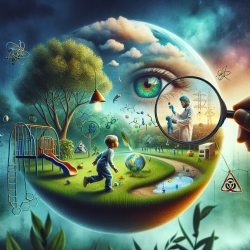As practitioners dedicated to fostering optimal outcomes for children, it is crucial to stay informed about factors that can impact their development. Recent research highlights a pressing concern: the potential developmental toxicity of environmental chemicals. The study "Chemicals in the environment and developmental toxicity to children: a public health and policy perspective" by Goldman and Koduru (2000) underscores the urgency of this issue and offers valuable insights for professionals in our field.
In this blog, we will explore the key findings of the research and discuss actionable steps that practitioners can take to mitigate risks and promote healthier developmental trajectories for children.
Understanding the Research
The research by Goldman and Koduru (2000) emphasizes the potential hazards posed by numerous pesticides and toxic chemicals in the environment, many of which have not been thoroughly evaluated for their developmental neurotoxicity. The study highlights several legislative measures, such as the 1996 Food Quality Protection Act (FQPA) and the Safe Drinking Water Act, which aim to address these concerns by requiring stringent safety assessments and additional risk factors for children.
Key points from the research include:
- Recognition of the special sensitivities of infants and children to environmental chemicals.
- Mandates for the U.S. Environmental Protection Agency (EPA) to ensure pesticide food use is safe for children.
- Incorporation of a 10-fold safety factor in risk assessments for pesticide residues.
- Examination of the potential endocrine-disrupting effects of chemicals in food and drinking water.
- Introduction of a voluntary chemical information program to screen high-volume chemicals in commerce.
These initiatives are critical steps towards safeguarding children's health, but they also underscore the need for continued research and vigilance.
Actionable Steps for Practitioners
As practitioners, we have a unique role in both implementing research findings and advocating for further investigation. Here are some actionable steps to consider:
1. Stay Informed and Educated
Continually update your knowledge about environmental chemicals and their potential impacts on child development. Attend workshops, webinars, and conferences that focus on this topic. Subscribe to relevant journals and follow updates from reputable organizations like the EPA.
2. Advocate for Safe Practices
Encourage schools and parents to adopt practices that minimize children's exposure to harmful chemicals. This includes advocating for the use of non-toxic cleaning products, safe pest control methods, and ensuring that food and drinking water meet safety standards.
3. Integrate Environmental Health into Assessments
When conducting assessments, consider environmental factors that may contribute to developmental issues. Ask questions about the child's exposure to potential toxins at home, school, and in the community. This holistic approach can provide a more comprehensive understanding of the child's developmental context.
4. Collaborate with Other Professionals
Work closely with other professionals, such as pediatricians, environmental health experts, and educators, to create a multidisciplinary approach to addressing developmental toxicity. Collaboration can lead to more effective interventions and advocacy efforts.
5. Encourage Further Research
Support and participate in research initiatives that aim to explore the impact of environmental chemicals on child development. This can include contributing to studies, collecting data, or advocating for funding and policy changes that prioritize this area of research.
Conclusion
The research by Goldman and Koduru (2000) provides a compelling case for the need to address the developmental toxicity of environmental chemicals. As practitioners, we have a responsibility to use this knowledge to improve our practices and advocate for safer environments for children. By staying informed, advocating for safe practices, integrating environmental health into assessments, collaborating with other professionals, and encouraging further research, we can make a significant impact on children's health and development.
To read the original research paper, please follow this link: Chemicals in the environment and developmental toxicity to children: a public health and policy perspective.










